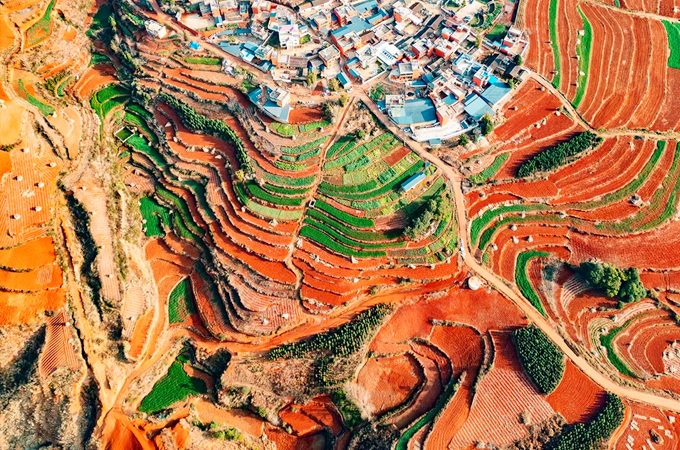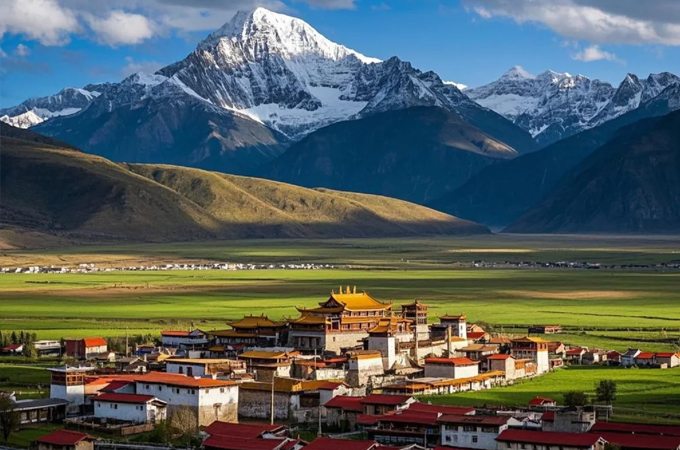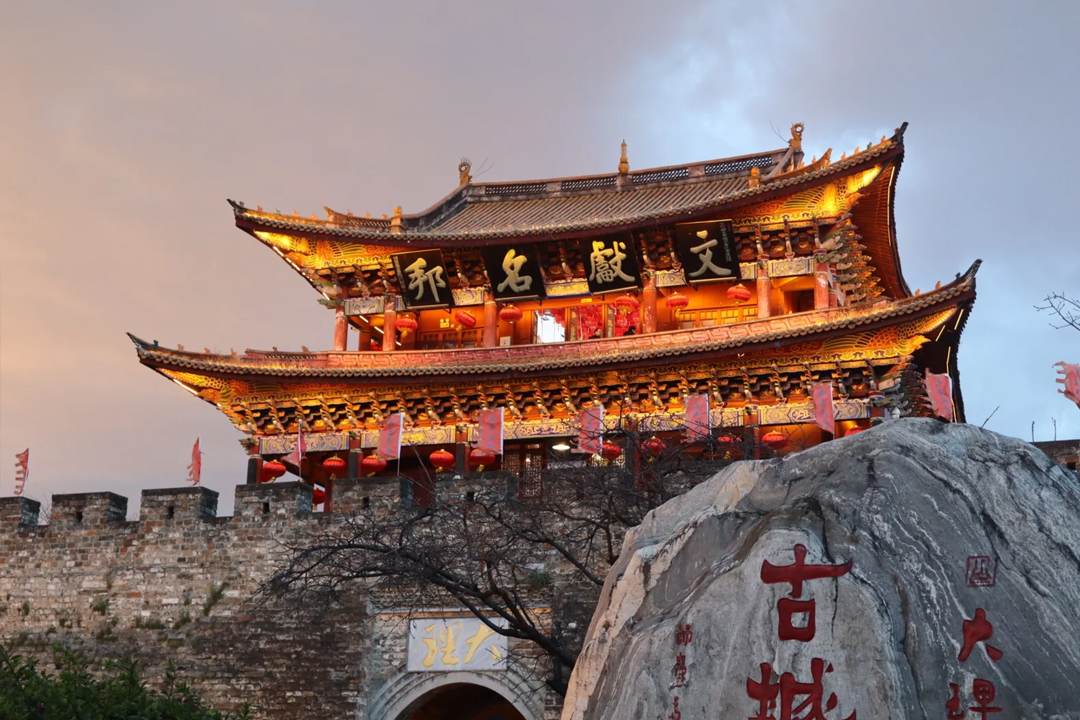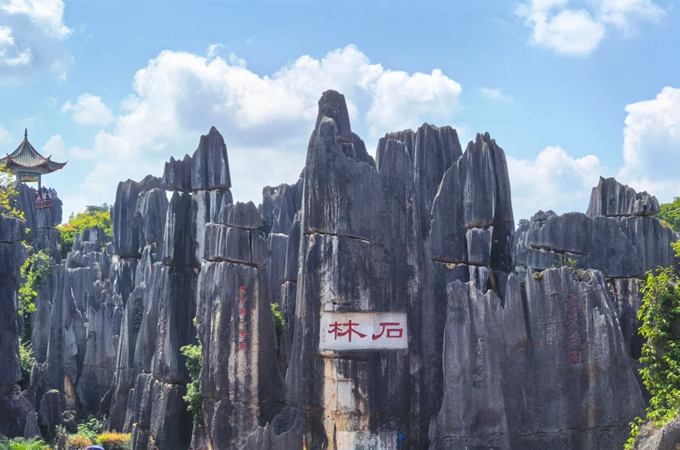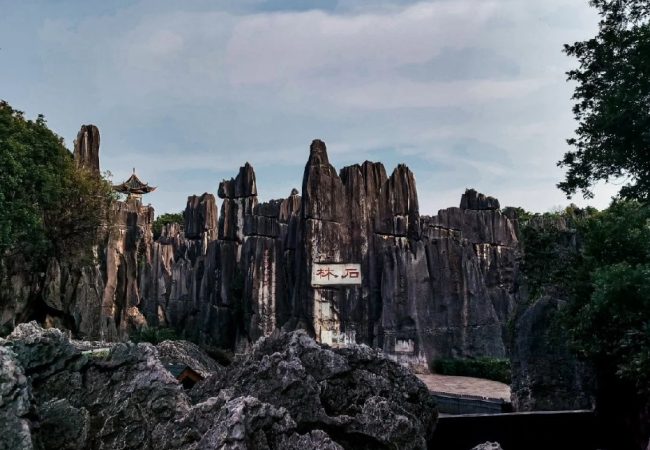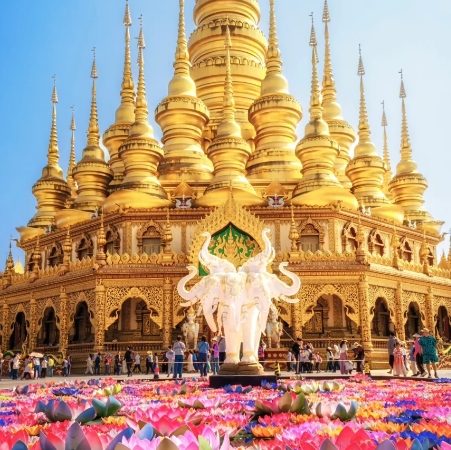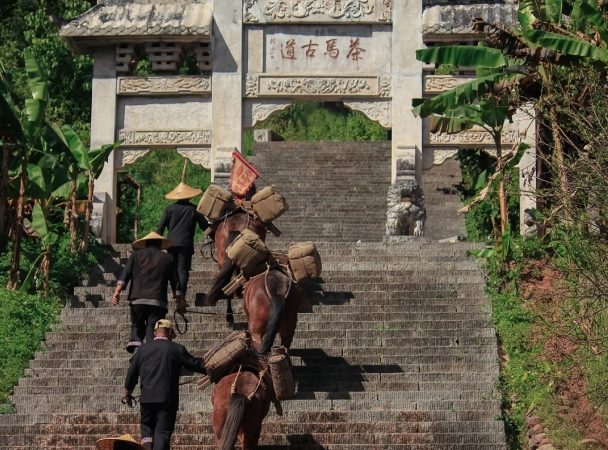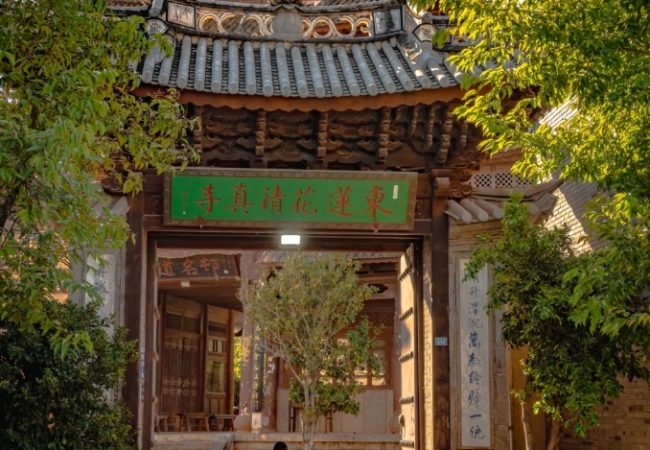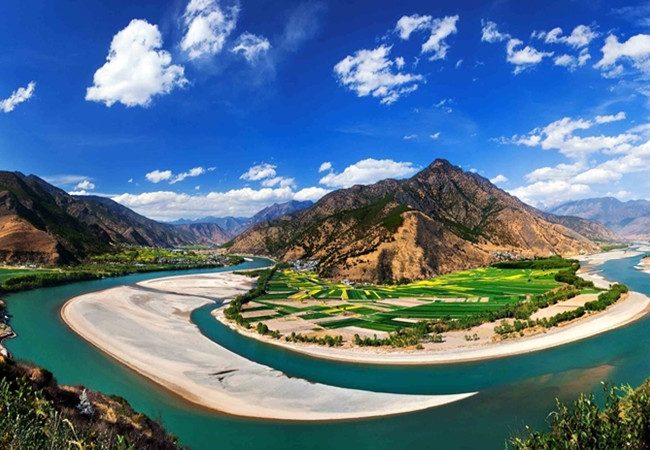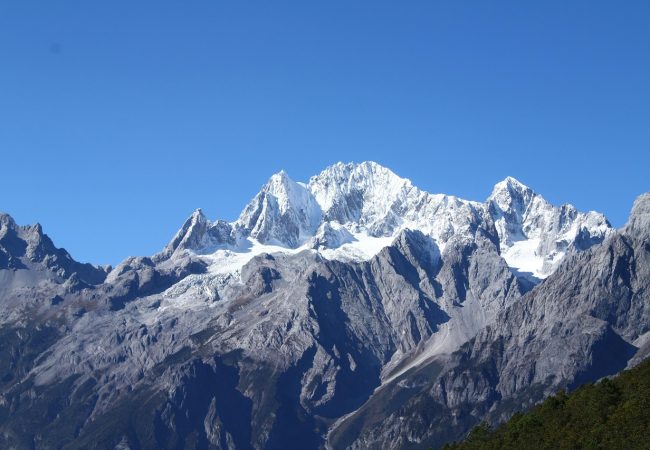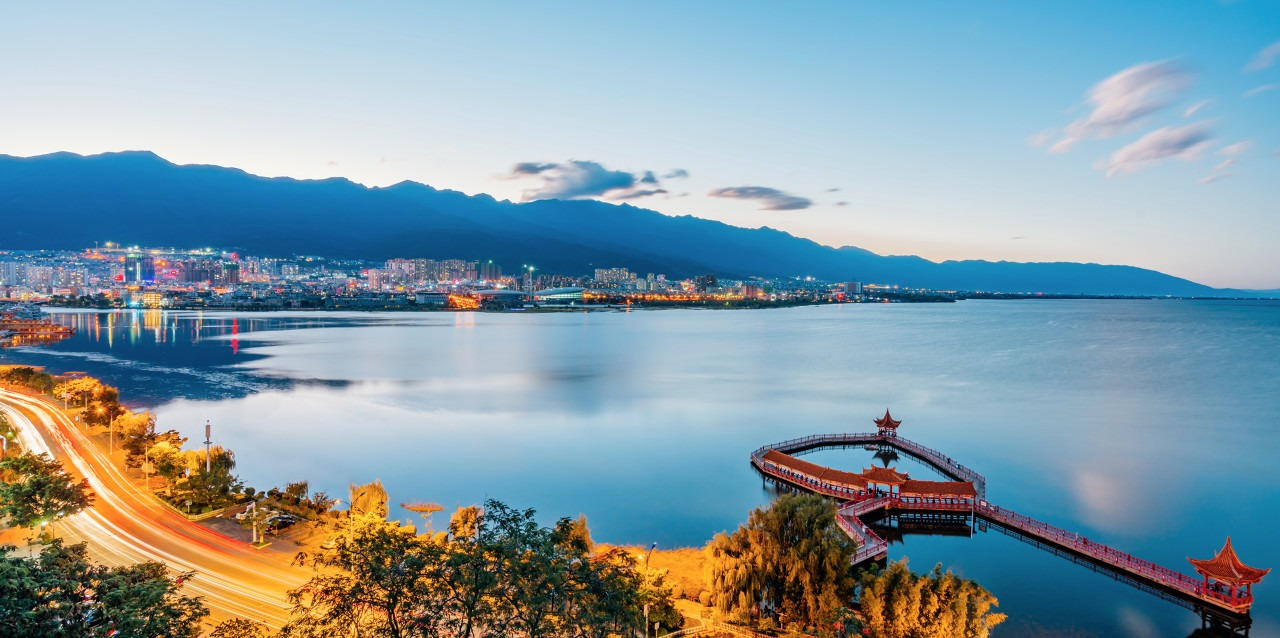
Dali Bai Autonomous Prefecture is located in the central-western part of Yunnan Province. Its geographical coordinates range from 98°52′ to 101°03′ east longitude and from 24°41′ to 26°42′ north latitude. It is adjacent to Chuxiong Yi Autonomous Prefecture (楚雄彝族自治州) in the east, leans against Pu’er City (普洱市) and Lincang City (临沧市) in the south, borders Baoshan City (保山市) and Nujiang Lisu Autonomous Prefecture (怒江傈僳族自治州) in the west, and connects with Lijiang City (丽江市) in the north. The seat of the prefectural government, Xiaguan in Dali City (大理市下关), is 331 kilometers away from Kunming City (昆明市), the capital of Yunnan Province. Thanks to its unique geographical location, it has become an important transportation hub and a gathering place for cultural exchanges in western Yunnan.
The terrain of the whole prefecture shows a trend of being higher in the northwest and lower in the southeast, with mountains and plateaus as the main landforms. The Diancang Mountain (点苍山) in the middle is part of the Yunling Mountains, a branch of the Hengduan Mountains. It is composed of nineteen majestic peaks running from north to south, with an altitude ranging from 3,500 meters to 4,122 meters. The peaks are covered with snow all year round, looking like a silver dragon winding and coiling. The Jinsha River Basin (金沙江流域) in the east has a relatively gentle terrain, and the flowing water nourishes the fertile land along the banks. While in the Lancang River (澜沧江) and Nu River (怒江) Basins in the west, there are overlapping mountains and deep valleys, fully demonstrating the uncanny craftsmanship of nature. The diversity of mountains and rivers has created a rich and diverse ecological environment and landscape features in Dali.
Human and Historical Background
As early as the Neolithic Age, the ancestors of ethnic minorities such as the Bai and Yi people lived and multiplied on this land of Dali, starting the chapter of human civilization. In 211 BC, the Dali area was officially incorporated into the unified feudal country of the Qin Dynasty and integrated into the big family of Chinese civilization. During the Tang and Song dynasties, two local regimes, the “Nanzhao Kingdom” (南诏国) and the “Dali Kingdom” (大理国), rose successively here, lasting for more than 500 years and creating a splendid and unique regional culture. When the Yuan Dynasty destroyed the Dali Kingdom, the ancient city was severely damaged in the war. It was not until 1382 (the 15th year of the Hongwu reign of the Ming Dynasty), after the Ming army captured Dali, that the prefectural city was rebuilt, which is the well-known Dali Ancient City (大理古城) today, carrying the profound historical memory of Dali.
Cultural Heritage
As the core birthplace of Bai culture, the cultural elements of the Bai people permeate all aspects of life in Dali. The architecture represented by Bai folk houses mostly adopts the classic patterns of “three houses with a screen wall” (“三坊一照壁”) and “four compounds with five courtyards” (“四合五天井”). With overhanging eaves, brackets, and exquisitely carved beams and pillars, every detail shows the superb architectural skills and aesthetic taste of the Bai people. Bai handicrafts such as tie-dyeing, embroidery, and woodcarving are also renowned. The tie-dyeing products are bright in color and simple in pattern; the embroidery works are delicate in stitching and lifelike; the woodcarving craftsmanship is exquisite and the shapes are vivid, all demonstrating the unique charm of Bai folk art.
Religious Culture
The religious culture in Dali is rich and diverse, with various religions such as Buddhism, Taoism, and Islam coexisting harmoniously and integrating with each other. The Three Pagodas of Chongsheng Temple (崇圣寺三塔), as the landmark building of Buddhist culture in Dali, is solemn and has stood firm after years of baptism. Jizu Mountain (鸡足山) is a famous Buddhist mountain. With its profound Buddhist heritage and beautiful natural scenery, it attracts countless believers and tourists to pay homage and sightsee, becoming an important holy land for the spread and exchange of religious culture.
Climate Characteristics
Dali City belongs to the northern subtropical plateau monsoon climate. The temperature difference between the four seasons is not significant, and the dry and wet seasons are clearly divided. It is known as having “the climate of all four seasons often like early spring, the cold stops at coolness, and the heat stops at warmth.” This pleasant climate makes Dali suitable for tourism throughout the year. No matter when you come, you can enjoy its comfortable and pleasant side. The average annual temperature in Dali is 14.9°C, and the annual sunshine hours reach 2,227.5 hours. The abundant sunshine endows Dali with bright sunlight. The annual precipitation is 1,051.1 millimeters. In winter and spring, the sky is clear, and the sun shines on the earth, with a relatively long sunshine time. In summer and autumn, there is more rainfall, and rainy and cloudy days are relatively frequent, bringing abundant water vapor to the earth, nourishing all things on this land, and adding a bit more poetry to the landscape of Dali in the mist and rain.
Recommended Scenic Spots
Natural Sceneries
Diancang Mountain (点苍山)
As a national-level scenic spot, nature reserve, and geopark, the nineteen peaks of Diancang Mountain are continuous. The snow on the peaks remains all year round and shines with a holy light under the sun. There are gurgling clear springs in the mountains, and the streams and waterfalls such as Qingbi Stream (清碧溪) and Qilongnv Pool (七龙女池) are lively. They are either like silver chains hanging in the air or like pearls splashing. Diancang Mountain also harbors rich and rare animal and plant resources and is a natural ecological treasure house. When tourists take the cable car up the mountain slowly, they can have a panoramic view of the sparkling Erhai Lake (洱海) and the quaint style of Dali Ancient City (大理古城), feeling the magnificent landscape where nature and humanity are intertwined.
Erhai Lake (洱海)
As one of the seven famous freshwater lakes in China, the water of Erhai Lake is as clear as a mirror, reflecting the blue sky, white clouds, and the green shadows of the surrounding Diancang Mountain. The lake and mountain scenery is breathtaking. Walking or cycling along the lakeside of Erhai Lake, the pastoral scenery of the fishing villages along the way is simple and peaceful. Occasionally, you can see fishermen rowing on the lake and casting their nets to catch fish. Tourists can also experience the fun of rowing boats firsthand and feel the tenderness of Erhai Lake up close, immersing their bodies and minds in this dreamlike lake scenery.
Cultural Sceneries
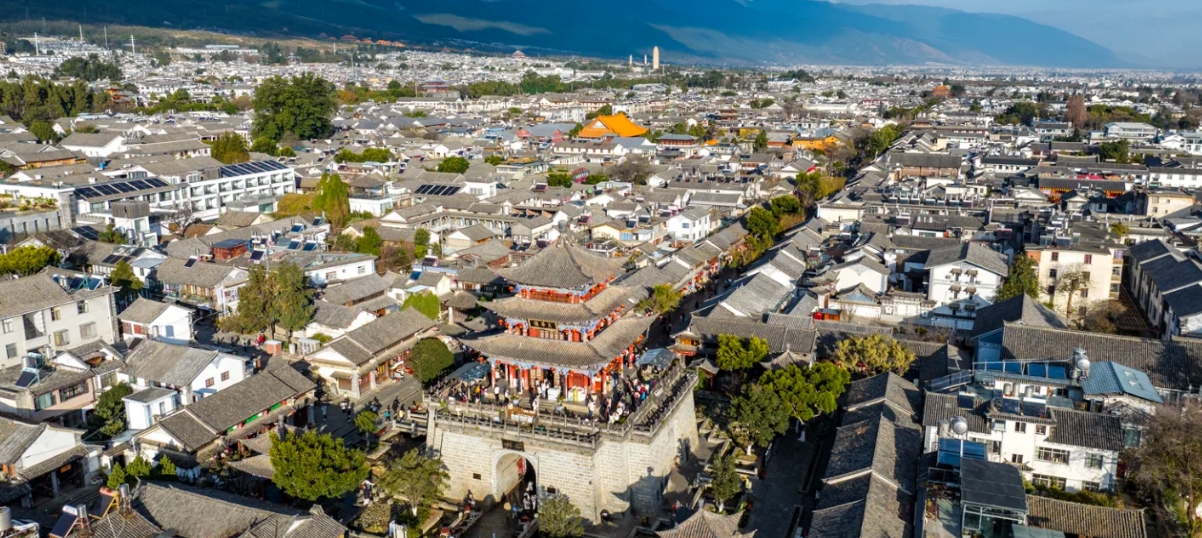
Dali Ancient City (大理古城)
Dali Ancient City is one of the first 24 national historical and cultural cities in China. The streets in the city are arranged in a typical chessboard pattern, neat and orderly. Ancient buildings such as the Wenxian Tower (文献楼), Wuhua Tower (五华楼), and Nancheng Tower (南城楼) are antique, carrying the traces of time. Historical sites such as the Taihe City Ruins (太和城遗址) and the Stele of Kublai Khan’s Conquest of Yunnan (元世祖平云南碑) quietly tell the glory and vicissitudes of Dali in the past. Walking on the flagstone roads of the ancient city, it is as if you have traveled through time and can truly feel the profound historical and cultural heritage.
Chongsheng Temple Three Pagodas Cultural Tourism Area (崇圣寺三塔文化旅游区)
The Three Pagodas of Chongsheng Temple are undoubtedly the landmark buildings of Dali. They are composed of one large pagoda and two small pagodas. The shape is unique, and the momentum is magnificent. The main pagoda, Qianxun Pagoda (千寻塔), is tall and straight, and the two small pagodas stand on both sides, echoing each other. As one of the famous pagodas in China, the Three Pagodas of Chongsheng Temple contain extremely high historical, cultural, and artistic values. They are the pinnacle of Buddhist culture in Dali and a must-visit cultural landscape for tourists coming to Dali.
Transportation Situation
Aviation
The route network of Dali Huangleiba Airport (大理荒草坝机场) is constantly expanding. Now, many domestic routes have been opened, which can directly fly to major domestic cities such as Beijing, Shanghai, Guangzhou, and Shenzhen. It has greatly shortened the time and space distance between Dali and all parts of the country, providing a convenient air passage for domestic and foreign tourists to travel to Dali.
Railway
There are railway stations such as Dali Station (大理站) and Dali East Station (大理东站) in Dali. The railway transportation is well-developed. Through the railway, tourists can conveniently go to cities within the province such as Kunming and Lijiang, and can also directly reach surrounding provinces and cities such as Chengdu and Chongqing. Whether it is traveling within the province or across provinces, railway travel is very convenient.
Road
There are many expressways and national highways crisscrossing in Dali, such as the 杭瑞 Expressway and the Dali-Lijiang Expressway (大丽高速), which closely connect Dali with surrounding areas. The road transportation network between counties and cities in the prefecture is complete, and the traffic is smooth. In addition, there are many long-distance buses traveling between Dali and surrounding cities, providing tourists with diverse travel options. Whether you explore by self-driving or take public transportation, you can easily reach various scenic spots in Dali.
Accommodation Options
Luxury Hotels
Luxury hotels such as Pullman Dali (大理铂尔曼酒店) and Hotel Indigo Dali Erhai (大理洱海天域英迪格酒店) have extremely luxurious facilities and meticulous services. Here, tourists can enjoy a top-notch accommodation experience. The rooms are equipped with modern high-end facilities, and outside the window is the beautiful scenery of Erhai Lake. You can see the scenery by opening the window, allowing your body and mind to be extremely relaxed in comfort and pleasure.
Characteristic Inns
There are a large number of unique inns distributed in places such as Dali Ancient City and Shuanglang Ancient Town (双廊古镇). Most of these inns retain the traditional architectural style of the Bai people, with white walls, green tiles, and overhanging eaves, which complement the surrounding environment. The interior environment of the inns is quiet and elegant, and the decoration is full of ethnic customs. The prices are also relatively affordable. When tourists stay in them, they can not only enjoy a comfortable accommodation environment but also deeply experience the rich local Bai culture and feel the warmth of home.
Food and Shopping
Special Cuisines
Three-Course Tea of Dali (大理三道茶)
The Three-Course Tea of Dali is a representative traditional drink of the Bai people, which consists of bitter tea, sweet tea, and aftertaste tea in sequence. The bitter tea is brewed with roasted tea. It tastes bitter at first but can refresh the mind. The sweet tea is added with ingredients such as walnuts, milk fans, and brown sugar, which is sweet and delicious and makes people feel happy. The aftertaste tea is accompanied by seasonings such as Chinese prickly ash and ginger slices, with a rich taste and endless aftertaste. The Three-Course Tea is not only a drink but also contains the philosophy of life that first comes bitterness, then sweetness, and finally the aftertaste of life. It is an essential important etiquette for the Bai people to receive distinguished guests.
Fish Dishes from Erhai Lake (洱海鱼鲜)
Erhai Lake is rich in products and produces a variety of fish such as Gongyu (弓鱼) and crucian carp. These fish are tender in meat and rich in nutrition. There are various local cooking methods. Steaming can best retain the original flavor of the fish, and the fish is tender and smooth; braising makes the fish bright in color and rich in taste; the sour and spicy flavor is particularly unique, stimulating the freshness of the fish with a strong sour and spicy soup, making people have a great appetite. Each cooking method can make people taste the unique charm of fish dishes from Erhai Lake.
Crispy Pastry (破酥粑粑)
The Crispy Pastry is divided into sweet and salty flavors. The outer skin is crispy, and it makes a crisp sound when you bite it gently. The inner filling is soft, sweet, or savory, with rich layers of taste. The production process is unique, slowly roasted over charcoal fire, and the aroma of wheat and the filling blend with each other. It is a characteristic snack that can be seen everywhere in the streets and alleys of Dali and is deeply loved by tourists and locals.
Shopping Recommendations
The characteristic handicrafts in Dali are diverse. The tie-dyeing products of the Bai people are unique. The fabrics, clothes, handkerchiefs, etc. are colorful, and the patterns mostly originate from the daily life and traditional culture of the Bai people. Each piece is unique. Bai woodcarving is famous for its exquisite craftsmanship. The craftsmen carve carefully, presenting subjects such as flowers, birds, fish, insects, and myths and legends vividly on the wood, which has great artistic and collection value. Marble products, relying on the rich stone resources in Dali, are processed into handicrafts with beautiful textures and excellent quality. The silverware is exquisitely made and comes in various styles, both decorative and practical. These characteristic products are excellent choices for tourists to give as gifts to relatives and friends or keep as souvenirs.
We hope this introduction helps you understand Dali and plan your trip more effectively.

